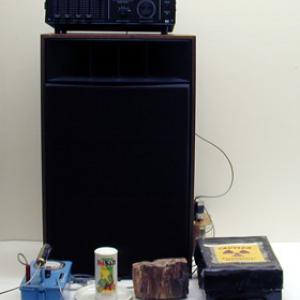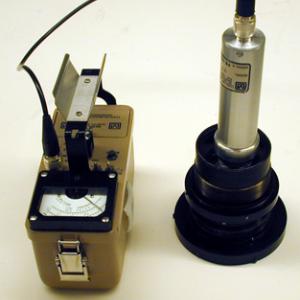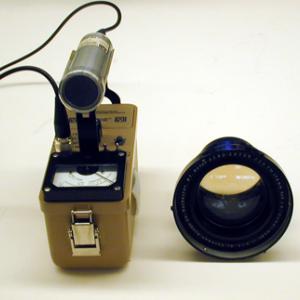College of Liberal Arts & Sciences
7D10.10 - Radioactivity Demo
Video Credit: Jonathan M. Sullivan-Wood
Plug the speaker into the speaker outputs of the amplifier. Plug the Geiger counter into the auxiliary input of the amplifier. Turn the amplifier on and turn the Geiger counter on to the desired scale. Bring the radioactive source close to the counter tube and hear the audible clicks. The radioactive sources are all labeled except for the large rock. The radioactivity is concentrated in the dark bands of the rock.
Salt substitute usually contains KCl as the active ingredient. Natural potassium has a significant amount of 40K which is one of the most abundant radioactive substances with a half-life of 1.277 billion years. The counting rate heard should be 3 to 4 times background.
Many of the old style lantern mantles use thorium as the main ingredient. The most abundant radioisotope of thorium is 232Th with a 14.05 billion year half-life.
Another cheap radioactive source can be purchased at the camera store. This is an anti-static brush that is used to neutralizes the static charge on dust and then wipe it away. A small amount of Polonium 210 is used for this neutralization. This brush with source will last for several years before it needs to be replaced. This is a very good source to use for the electrostatic discharge of a parallel plate capacitor (5D40.30).
The Aero-Ektar lens is a World War II aerial reconnaissance lens. To get the high index of refraction needed for a fast lens two elements of the compound lens were doped with Thorium. To test for radioactivity screw off the back mount part of the lens so that you can get the detector close to the back side of the lens. A count rate similar to the uranium plate should be heard.
Commonly Found Radioactive Sources:
- Smoke Detector = Americium 241.
- Salt Substitute = Potassium 40.
- Radon = Can be collected on TV screens or with a statically charged balloon. Common in the Midwest and upper eastern states.
- Coleman style Lantern Mantles = Thorium.
- Fiesta Ware = Uranium oxide.
- Antistatic Brushes = Polonium 210.
- Cigarettes = The tobacco plant concentrates Polonium 210 while it is growing and the smoke particles attract and collect Radon in the lungs when smoked. Double Whammy.
- TIG welding rod = Thoriated rod = 2% Thorium, good for cloud chamber source.
- Thorium impregnated camera lenses = the Aero-Ectar lenses.
- Vaseline glass = Uranium oxide and also fluoresces under black light.
- Cosmic Rays.
- Natural sources = Uranium concentrated in the dark bands from many of the rock collected in the west and southwest.
Other natural sources and their locations:
Autunite - Montebras, France
Carnotite in Sandstone - Montrose Co., Colorado
Cyrtolite, uranium bearing - Bancroft , Ontario , Canada
Ellsworthite (Pyrochore in Calcite) - Hybla , Ontario, Canada
Euxenite - Voandelaka, Madagascar
Fergusonite - Madawaska, Ontario, Canada
Gummite with Uraninite, etc. - near Grafton Center, New Hampshire
Monazite - Elk Mtns., San Miguel Co., New Mexico
Monazite Sand - Idaho
Polycrase-Euxenite - Minas Gerais, Brazil
Samarskite - Mitchell County, North Carolina
Torbernite (Meta-Torbernite) - Mitchell County, North Carolina
Uraninite (Pitchblende) - Great Bear Lake, Northwest Territories
Uraninite - Mitchell County, North Carolina
Uranophane - Ruggles Mine, near Grafton Center, New Hampshire
- Calin Galeriu, Goeffrey Esper, Cristina Miron, "Nuclear Physics with MightyOhm: Evidence of Radiation Scattering", TPT, Vol. 62, #9, Dec. 2024, p. 731.
- Yugjeet S. Grewal, Raul Fernando Reynoso, Ruben Reyes, John R. Walkup, Michael A. Walkup, "Online Radiation Experiment on Gamma-Ray Absorption From an Early Quack Device", TPT, Vol. 60, #7, Oct. 2022, p. 578.
- Paul Hewitt, "Figuring Physics February Answer", TPT, Vol. 58, #3, Mar. 2020, p. 214.
- Ulf Stahmer, "Stahmer’s Response", TPT, Vol. 57, #2, Feb. 2019, p. 67.
- SMJ Mortazavi and Joseph John Bevelacqua, "Comment on 'Using Flight-Time to Contextualize Radiological Dose'", TPT, Vol. 57, #2, Feb. 2019, p. 67.
- Ulf Stahmer, "Using Flight-Time to Contextualize Radiological Dose", TPT, Vol. 56, #8, Nov. 2018, p. 508.
- Christopher Sirola, "May the Forces be with You!", TPT, Vol. 56, #2, Feb. 2018, p. 118.
- Paul Hewitt, "Figuring Physics: Electric Force and the Nucleus", TPT, Vol. 53, #2, Feb. 2015, p. 70.
- Susanne Neumann, "Three Misconceptions About Radiation - And What We Teachers Can Do to Confront Them", TPT, Vol. 52, #6, Sept. 2014, p. 357.
- Jochen Kuhn, Alexander Molz, Sebastian Gröber, and Jan Frübis, "iRadioactivity - Possibilities and Limitations for Using Smartphones and Tablet PCs as Radioactive Counters", TPT, Vol. 52, #6, Sept. 2014, p. 351.
- Kemi Jona and Mark Vondracek, "A Remote Radioactivity Experiment", TPT, Vol. 51, #1, Jan. 2013, p. 25.
- Joseph John Bevelacqua, "Radiological Dispersion Devices and Basic Radiation Science", TPT, Vol. 48, #5, May 2010, p. 302.
- David R. Lapp, "Obtaining and Investigating Unconventional Sources of Radioactivity", TPT, Vol. 48, #2, Feb. 2010, p. 90.
- David R. Lapp, "Teaching Nuclear Radiation and the Poisoning of Alexander Litvinenko", TPT, Vol. 46, #3, Mar. 2008, p. 160.
- Paul Hewitt, "Figuring Physics: Fission-Fusion Curve", TPT, Vol. 43, #3, May 2005, p. 264.
- Christopher G. Deacon, "A Background to Background Radiation", TPT, Vol. 41, #2, Feb. 2003, p. 78.
- Paul Hewitt, "Figuring Physics: Common Granite Rock", TPT, Vol. 38, #6, Sept. 2000, p. 346.
- Douglas E. Peplow, "Fiestaware™ Radiography", TPT, Vol. 37, #5, May 1999, p. 316.
- Ludwik Kowalski, "Will New Technology Solve the Nuclear Waste Problem?", TPT, Vol. 35, #1, Feb. 1997, p. 126.
- Carson A. Riland, "Environmental Radioactivity, Temperature, and Precipitation", TPT, Vol. 34, #4, Apr. 1996, p. 234.
- Howard C. Hayden, "Erratum: 'High‐Level Radioactive Waste' [TPT, October 33, 450 (1995)]", TPT, Vol. 34, #1, Jan. 1996, p. 4.
- Michael C. Boyer, "Environmental Radioactivity and the Weather", TPT, Vol. 33, #9, Dec. 1995, p. 554.
- Gary Kessler, "Recycle Outmoded Air-Track Components", TPT, Vol. 33, #7, Oct. 1995, p. 473.
- Howard C. Hayden, "High-Level Radioactive Waste", TPT, Vol. 33, #7, Oct. 1995, p. 450.
- Jack G. Couch and Kelly L. Vaughn, "Radioactive Consumer Products in the Classroom", TPT, Vol. 33, #1, Jan. 1995, p. 18.
- Lawrence Ruby, "If You Understand Leaky Buckets, You Understand A Lot of Physics", TPT, Vol. 29, #1, Jan. 1991, p. 44.
- Richard E. Berg, "More Leaky Buckets", TPT, Vol. 29, #5, May 1991, p. 266.
- Kenneth Hartt, "Beta Decay", TPT, Vol. 26, #7, Oct. 1988, p. 471.
- John E. Peterson, "The Energy Crisis Is Still With Us", TPT, Vol. 24, #7, Oct. 1986, p. 444.
- Ronald A. Kobiske, "Those Betas Can Make a Difference", TPT, Vol. 18, #6, Sept. 1980, p. 406.
- G. Stroink, "Radiation Safety in the Lab", TPT, Vol. 18, #3, Mar. 1980, p. 207.
- David A. Smith, "A Negative MPD?", TPT, Vol. 15, #7, Oct. 1977, p. 388.
- Peter Lindenfeld, "Does Doctor Always Know Best?", TPT, Vol. 15, #6, Sept. 1977, p. 325.
- Stewart C. Bushong, "The Author Replies", TPT, Vol. 15, #6, Sept. 1977, p. 382.
- Stewart C. Bushong, "Radiation Exposure in Our Daily Lives", TPT, Vol. 15, #3, Mar. 1977, p. 135.
- J. C. Widman, J. Brnetich, and E. R. Powsner, "A Radioactive Decay Flow Diagram", TPT, Vol. 13, #9, Dec. 1975, p. 554.
- Michael Davis, "Department of Forgotten Lore: What's a Spinthariscope?", TPT, Vol. 12, #7, Oct. 1974, p. 406.
- Karl Z. Morgan, "Comments on Radiation Hazards and Risks", TPT, Vol. 9, #7, Oct. 1971, p. 415.
- Florence G. Freilich, "Radiation and People", TPT, Vol. 8, #9, Dec. 1970, p. 499.
- John W. Sulcoski, "Making Inexpensive Accessories for Nuclear Education", TPT, Vol. 7, #5, May 1969, p. 300.
- James Barker, "Spinthariscopes", TPT, Vol. 7, #4, Apr. 1969, p. 244.
- Richard O. Thomas, "A Device for Demonstrating Half-Thickness of Shielding Materials", TPT, Vol. 4, #2, Feb. 1966, p. 77, also A Potpourri of Physics Teaching Ideas - Odds and Ends, p. 316.
- Edith H. Quimby, "Safe Use of Ionizing Radiation In Secondary Schools", TPT, Vol. 3, #4, Apr. 1965, p. 158.
- Frederic W. Kantor, "Using Polaroid Land Sheet Film Packets For Radiation Experiments and Demonstrations", TPT, Vol. 3, #3, Mar. 1965, p. 125.
- A. S. Eve, "Early History of Radioactivity", TPT, Vol. 1, #5, Nov. 1963, p. 240.
- Rebekah Aguilar, Patrick Powers, Nina Abramzon, P. B. Siegel, "Soil Analysis Using a 2" Gamma Detector", AJP, Vol. 89, #6, June 2021, p. 647.
- Alberto De Gregorio, "Radioactivity Induced by Neutrons: Enrico Fermi and a Thermodynamic Approach to Radiative Capture", AJP, Vol. 74, #7, July 2006, p. 614.
- Barbara Hoeling, Douglas Reed and P. B. Siegel, "Going Bananas in the Radiation Laboratory", AJP, Vol. 67, #5, May 1999, p. 440.
- A. J. Howard, S. E. Carroll, and W. P. Strange, "A Simple System for Radon-in-Air Concentration Determinations", AJP, Vol. 59, #6, June 1991, p. 544.
- Bernard L. Cohen, "The Nuclear Reactor Accident at Chernobyl, USSR", AJP, Vol. 55, #12, Dec. 1987, p. 1076.
- John Luetzelschwab, "Determining the Age of Gas Lantern Mantles Using Gamma-Ray Analysis", AJP, Vol. 51, #6, June 1983, p. 538.
- P. J. Ouseph and Andrew Mostovych, "An Experiment to Measure Range, Range Straggling, Stopping Power, and Energy Straggling of Alpha Particles in Air", AJP, Vol. 46, #7, July 1978, p. 742.
- Lawrence Badash, "Radioactivity Before the Curies", AJP, 33, #2, Feb. 1965, p. 128.
- Jeffry A. Siegel, Charles W. Pennington, and Bill Sacks, "The Linear No-Threshold Theory: Readers Weigh In", Physics Today, Vol. 69, #7, July 2016, p. 14.
- W. Gale Biggs, "The Linear No-Threshold Theory: Readers Weigh In", Physics Today, Vol. 69, #7, July 2016, p. 14.
- Donald F. Nelson, Richard E. Thompson, Joel H. Popkin, and Zenaida Popkin, "The Linear No-Threshold Theory: Readers Weigh In", Physics Today, Vol. 69, #7, July 2016, p. 13.
- Leon N. Cooper and Michael Antosh, "The Linear No-Threshold Theory: Readers Weigh In", Physics Today, Vol. 69, #7, July 2016, p. 12.
- Elizabeth Shields and Stewart Carlyle Bushong, "The Linear No-Threshold Theory: Readers Weigh In", Physics Today, Vol. 69, #7, July 2016, p. 12.
- Jan Beyea, "The Linear No-Threshold Theory: Readers Weigh In", Physics Today, Vol. 69, #7, July 2016, p. 11.
- Bemmet Alemayehu and Thomas Cochran, "The Linear No-Threshold Theory: Readers Weigh In", Physics Today, Vol. 69, #7, July 2016, p. 10.
- J. S. Levinger, "The Linear No-Threshold Theory: Readers Weigh In", Physics Today, Vol. 69, #7, July 2016, p. 10.
- Jeffry Siegel, Charles Pennington, and Bill Sacks, "Low-Dose Radiation Exposure Should Not Be Feared", Physics Today, Vol. 69, #1, Jan. 2016, p. 12.
- Johanna Miller, "Time to Reset Isotopic Clocks?", Physics Today, Vol. 65, #6, June 2012, p. 20.
- Eugen Merzbacher, "Radioactive Toothpaste and Reversed Helicity", Physics Today, Vol. 65, #4, Apr. 2012, p. 10.
- James S. Dickson, "Radiation Meets Food", Physics Today, Vol. 65, #2, Feb. 2012, p. 66.
- Joseph C. McDonald, Bert M. Coursey, and Michael Carter, "Detecting Illicit Radioactive Sources", Physics Today, Vol. 57, #11, Nov. 2004, p. 36.
- Frederick Sietz and Eugene P. Wigner, "The Effects of Radiation on Solids", Scientific American, Vol. 195, #2, Aug. 1956, p. 76.
- "How High is the Elevated Level of Radiation You're Exposed to on a Plane? Do Pilots Have a Greater Cancer Risk?", Popular Mechanics, Vol. 192, #10, Nov. 2015, p. 33.
- D. Rae Carpenter Jr. and Richard B. Minnix, "S-250. Chips-Cups-Nickels-Dominoes", DICK and RAE Physics Demo Notebook, 1993.
- G. D. Freier and F. J. Anderson, "MPa-2", A Demonstration Handbook for Physics.
- Borislaw Bilash II and David Maiullo, "Emit It!", A Demo a Day: A Year of Physics Demonstrations, p. 366.
- Chris Smolinski, "Radioactive Products and Other Sources Of Radiation".
- "It's Radioactive!", Uncle John's Bathroom Reader, 2007, p. 195.
- Dick Goodspeed, "Teaching Tip! Whole Body Radiation", Equipment & Supplies Safety, D149.
- Isaac Asimov, "Into the Here", Fantasy and Science Fiction Magazine, p. 138.
- Isaac Asimov, "Out of the Everywhere", Fantasy and Science Fiction Magazine, p. 129.
- Isaac Asimov, "The Unrecognized Danger", Fantasy & Science Fiction Magazine, p. 108.
- Isaac Asimov, "Royal Gamma", Fantasy & Science Fiction, p. 130.
- Isaac Asimov, "Skimming the Nearest", Fantasy & Science Fiction, p. 115.
- "Emission Characteristics of Alpha Particles", Selective Experiments in Physics, CENCO, 1962.
- "Experiments in Radioactivity", Selective Experiments in Physics, CENCO, 1962.
- W. Bolton, "38. The Back-Scattering of Beta Particles", Book 3. Atomic Physics, Physics Experiments and Projects, 1968, p. 83 - 84.
- W. Bolton, "35. Thorium Series", Book 3. Atomic Physics, Physics Experiments and Projects, 1968, p. 77 - 78.
- W. Bolton, "30. Variation of Intensity with Distance From the Source for Gamma Radiation", Book 3. Atomic Physics, Physics Experiments and Projects, 1968, p. 67 - 68.
- W. Bolton, "26. The Absorption of Gamma Radiation", Book 3. Atomic Physics, Physics Experiments and Projects, 1968, p. 59 - 60.
- W. Bolton, "25. The Absorption of Beta Radiation", Book 3. Atomic Physics, Physics Experiments and Projects, 1968, p. 57 - 58.
- W. Bolton, "17. The Action of the Radiations on a Photographic Plate", Book 3. Atomic Physics, Physics Experiments and Projects, 1968, p. 42.
- W. Bolton, "Specimen Project", Book 3. Atomic Physics, Physics Experiments and Projects, 1968, p. xi - xiv.
Disclaimer: These demonstrations are provided only for illustrative use by persons affiliated with The University of Iowa and only under the direction of a trained instructor or physicist. The University of Iowa is not responsible for demonstrations performed by those using their own equipment or who choose to use this reference material for their own purpose. The demonstrations included here are within the public domain and can be found in materials contained in libraries, bookstores, and through electronic sources. Performing all or any portion of any of these demonstrations, with or without revisions not depicted here entails inherent risks. These risks include, without limitation, bodily injury (and possibly death), including risks to health that may be temporary or permanent and that may exacerbate a pre-existing medical condition; and property loss or damage. Anyone performing any part of these demonstrations, even with revisions, knowingly and voluntarily assumes all risks associated with them.


